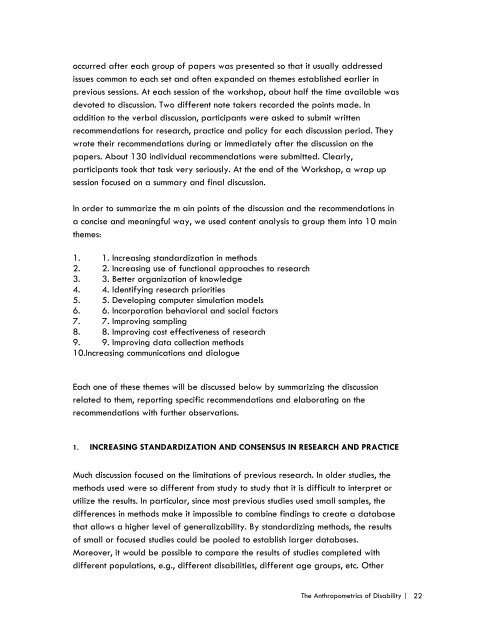The Anthropometrics of Disability - Designing Accessible Communities
The Anthropometrics of Disability - Designing Accessible Communities
The Anthropometrics of Disability - Designing Accessible Communities
You also want an ePaper? Increase the reach of your titles
YUMPU automatically turns print PDFs into web optimized ePapers that Google loves.
occurred after each group <strong>of</strong> papers was presented so that it usually addressed<br />
issues common to each set and <strong>of</strong>ten expanded on themes established earlier in<br />
previous sessions. At each session <strong>of</strong> the workshop, about half the time available was<br />
devoted to discussion. Two different note takers recorded the points made. In<br />
addition to the verbal discussion, participants were asked to submit written<br />
recommendations for research, practice and policy for each discussion period. <strong>The</strong>y<br />
wrote their recommendations during or immediately after the discussion on the<br />
papers. About 130 individual recommendations were submitted. Clearly,<br />
participants took that task very seriously. At the end <strong>of</strong> the Workshop, a wrap up<br />
session focused on a summary and final discussion.<br />
In order to summarize the m ain points <strong>of</strong> the discussion and the recommendations in<br />
a concise and meaningful way, we used content analysis to group them into 10 main<br />
themes:<br />
1. 1. Increasing standardization in methods<br />
2. 2. Increasing use <strong>of</strong> functional approaches to research<br />
3. 3. Better organization <strong>of</strong> knowledge<br />
4. 4. Identifying research priorities<br />
5. 5. Developing computer simulation models<br />
6. 6. Incorporation behavioral and social factors<br />
7. 7. Improving sampling<br />
8. 8. Improving cost effectiveness <strong>of</strong> research<br />
9. 9. Improving data collection methods<br />
10.Increasing communications and dialogue<br />
Each one <strong>of</strong> these themes will be discussed below by summarizing the discussion<br />
related to them, reporting specific recommendations and elaborating on the<br />
recommendations with further observations.<br />
1. INCREASING STANDARDIZATION AND CONSENSUS IN RESEARCH AND PRACTICE<br />
Much discussion focused on the limitations <strong>of</strong> previous research. In older studies, the<br />
methods used were so different from study to study that it is difficult to interpret or<br />
utilize the results. In particular, since most previous studies used small samples, the<br />
differences in methods make it impossible to combine findings to create a database<br />
that allows a higher level <strong>of</strong> generalizability. By standardizing methods, the results<br />
<strong>of</strong> small or focused studies could be pooled to establish larger databases.<br />
Moreover, it would be possible to compare the results <strong>of</strong> studies completed with<br />
different populations, e.g., different disabilities, different age groups, etc. Other<br />
<strong>The</strong> <strong>Anthropometrics</strong> <strong>of</strong> <strong>Disability</strong> | 22


